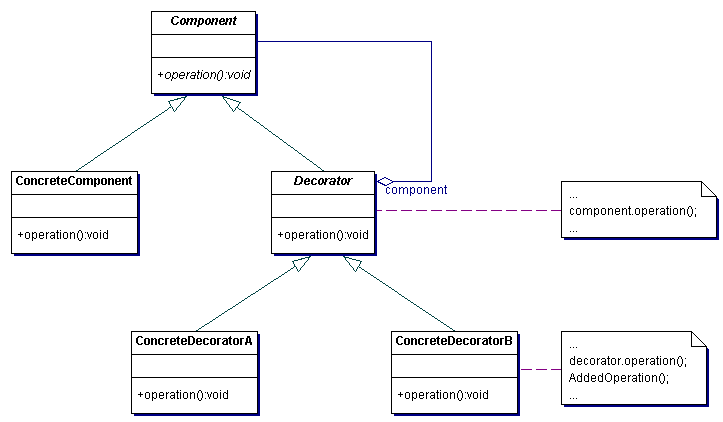
Widget* aWidget = new BorderDecorator(
new HorScrollDecorator(
new VerScrollDecorator(
new TextWidget( 80, 24 ))));
aWidget->draw();
Another example could be cascading responsibilities on to an output stream -
Stream* aStream = new CompressingStream(
new ASCII7Stream(
new FileStream( "fileName.dat" )));
aStream->putString( "Hello world" );
The solution to this problem involves encapsulating the original object
inside an abstract wrapper interface. Both the decorator objects and
the core object inherit from this abstract interface. The interface
uses recursive composition to allow an unlimited number of decorator
"layers" to be added to each core object.Note that this pattern allows responsibilities to be added to an object, not methods to an object's interface. The interface presented to the client must remain constant as successive layers are specified.
Also note that the core object's identity has now been "hidden" inside of a decorator object. Trying to access the core object directly is now a problem.

Non-software example
Adapter changes an object's interface, Decorator enhances an object's responsibilities. Decorator is thus more transparent to the client. As a consequence, Decorator supports recursive composition, which isn't possible with pure Adapters. [GOF, p149]
Composite and Decorator have similar structure diagrams, reflecting the fact that both rely on recursive composition to organize an open-ended number of objects. [GOF, p219]
A Decorator can be viewed as a degenerate Composite with only one component. However, a Decorator adds additional responsibilities - it isn't intended for object aggregation. [GOF, p184]
Decorator is designed to let you add responsibilities to objects without subclassing. Composite's focus is not on embellishment but on representation. These intents are distinct but complementary. Consequently, Composite and Decorator are often used in concert. [GOF, p220]
Composite could use Chain of Responsibility to let components access global properties through their parent. It could also use Decorator to override these properties on parts of the composition. [GOF, p349]
Decorator and Proxy have different purposes but similar structures. Both describe how to provide a level of indirection to another object, and the implementations keep a reference to the object to which they forward requests. [GOF, p220]
Decorator lets you change the skin of an object. Strategy lets you change the guts. [GOF, p184]